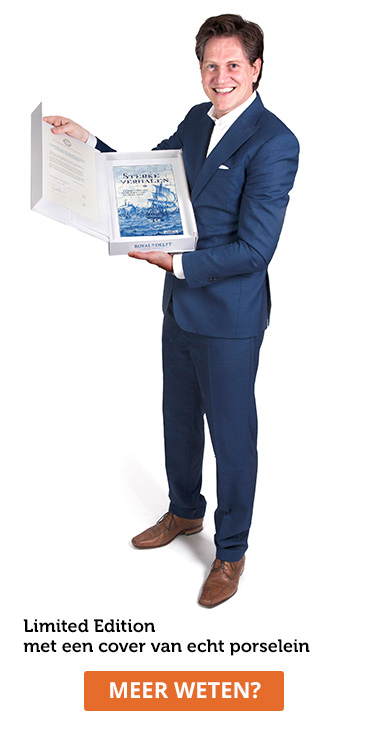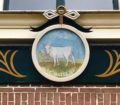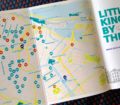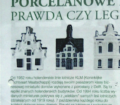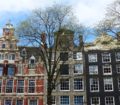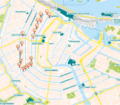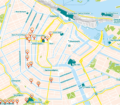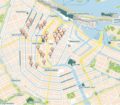Amsterdam has a number of centuries-old bars. Join this fun and entertaining historic pub crawl, have a drink in the oldest bar (from 1519), discover the secrets behind the red star of Heineken, meet a ghost in the gutter and sip Dutch genever from a tulip-shaped glass. Urban legends are waiting around the corner.
Today I share with you the hidden and fascinating stories behind the facade of a number of historic buildings. And even the bricks of the gables will reveal a weird secret, which can only be discovered with your tongue…by licking the façade!
Some of the monuments along this historic pub crawl are known the world over. These canal houses and national landmarks served as an inspiration for souvenirs in Delft Blue. The miniatures have become a phenomenon in the world of travel, because they are filled with genever and KLM Royal Dutch Airlines presents them as a gift to Business Class passengers. During this historic pub crawl you will learn about the great people who once lived in the iconic collection of KLM Houses. And you will discover the treasures of Amsterdam, hidden around the corner.
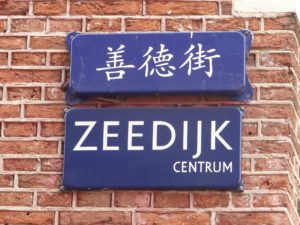
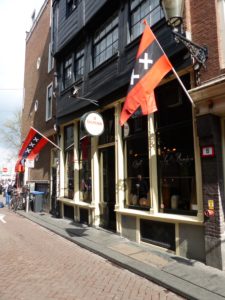
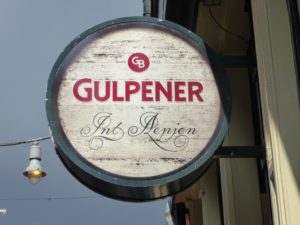
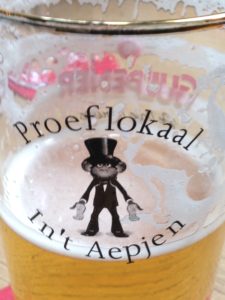
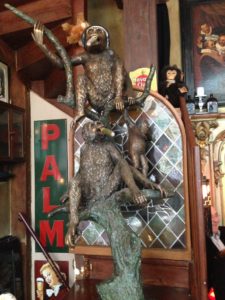
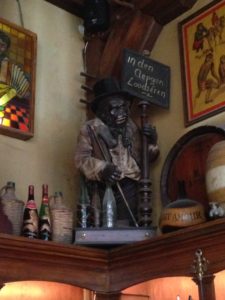
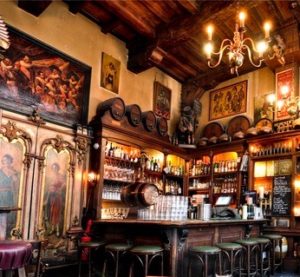
1.Café In ‘t Aepjen
Zeedijk 1
This is our first stop, Cafe In ‘t Aepjen, I want to start with Amsterdam’s oldest urban legend. In the early days, the owner of this pub used to accept monkeys as payment from sailors who were short of cash. Those were the days! I will come back to that later.
The old tavern offers a wide range of beers and lots of monkey memorabilia, like stuffed monkeys and statues everywhere you look. The first stop of our historic pub crawl is a great little place to have a drink. But let me tell you a bit of its history. Almost five centuries ago, café In ‘t Aepjen opened its doors and provided beer, Dutch genever, food and lodgings. It is housed in one of Amsterdam’s oldest historic buildings, dating back to 1519. Of all the wooden houses that made up this historic city, only two have survived: Café In ‘t Aepjen, and a wooden building in the Begijnhof.
But let me guess, you are probably more interested in the monkey business and the name of this pub, right? Well, in the old days, sailors returning from their exotic travels in the Far East anchored their ships close to the Zeedijk (literally sea dike), so right here. In their favorite pub, the men apparently used to trade their pet monkeys for more drinks or a bed for the night, if they had run out of money. Soon the place was full of apes and the customers began to complain about the fleas. A regular visitor kept the animals in his garden, which would eventually become Artis Zoo, one of the oldest zoos in Europe.
In Dutch, there’s even an expression referring to this café: ‘In de aap gelogeerd, literally ‘to stay in the monkey’, meaning that you have been taken for a fool. This refers to the times when unemployed poor wretches, hanging around the city, were picked up by tradesmen who gave them food and paid for a room at the guesthouse In ‘t Aepjen. In return, the tradesmen would sell the poor men to the shipping company, VOC. They were called ‘traders of the soul’ because many of the newly employed sailors spent the rest of their life paying off their debts to the tradesmen.
We walk northeast and turn left at the end, cross the Damrak (Central Station is on your right) and keep walking.
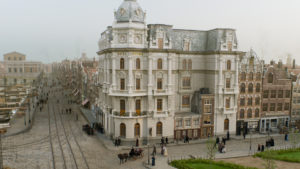
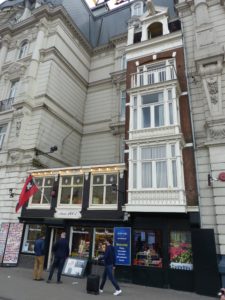
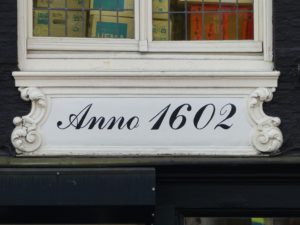
2.Urban Legend: the bluff related to the Victoria Hotel
Prins Hendrikkade 47
Our next stop is another legendary bar which can even proof its age with an official drinking license, dating back to 1606. But before we reach that historic hot spot, have a look at an architectural anomaly, in front of you. On the corner is Grand Hotel Victoria. It opened its doors in 1883 and was the first to have electric lighting throughout the whole building. From the very first day, the hotel attracted the rich and famous, such as members of royal families, the world-class exotic belly dancer and spy Mata Hari and entertainer Louis Armstrong.
You see the two 17th-century facades on the side of the Central Station? These two little houses, dating back to 1602, were supposed to be demolished to make room for the hotel. The owners were offered big money but they refused to sell their property and waited for a better deal. The householders’ bluff and stubborn determination led to nothing. In the end, the developer lost his temper and started to build the hotel around the two houses. The amazing story has been recorded in a book and led to a blockbuster movie.
Continue along the Prins Hendrikkade, and cross the street towards Café Karpershoek.
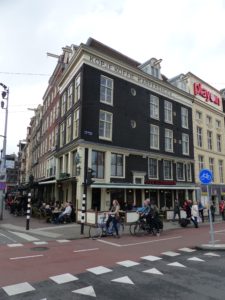

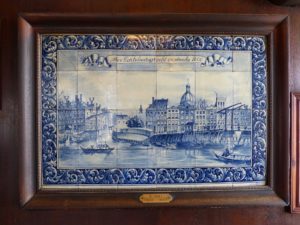
3. Café Karpershoek
Martelaarsgracht 2
Right in front of you is our second stop. This is Café Karpershoek, which originated in 1606 as a guesthouse for the crews of ships of the Dutch East India Company.
The street Martelaarsgracht or Martyr’s Canal, you just crossed, is named after the nearby location where criminals in the 17th century were executed. They were hung at a central place in town to serve as an example for others. In the nineteenth century, the canal was filled up, and the harbour moved to another part of Amsterdam, in order to make room for the Central Station. Café Karpershoek remained mostly unchanged.
Just have a look inside. It has a wall with 400 year-old Delft blue tiles. The other walls are covered with old sayings and wisdom, mixed with detailed wood carving and a colorful collection of pictures and paintings. Hey, and don’t be tempted to take a broom and start sweeping the floor. The sand on the floor as a special purpose. In earlier times, visitors to the pub liked to chew tobacco. After chewing it, they would spit the sticky stuff onto the ground. Because of the sand on the floor, it was easy to clean. Nowadays, no one chews tobacco, but the sand remains, as a sign that Café Karpershoek has withstood the test of time.
Walk along Martelaarsgracht to the south west, cross the street and walk into Nieuwendijk, turn right. Turn right into Kolksteeg. Further down the alley, on number 3, is our next stop: ‘In de Wildeman’.
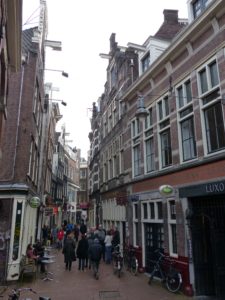


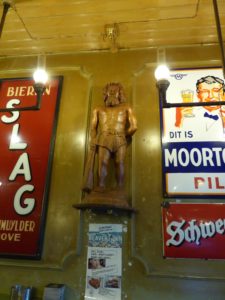
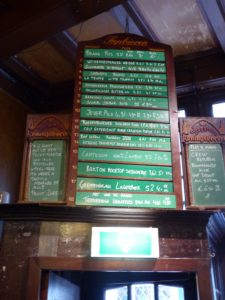
4. Tasting house ‘In de Wildeman’
Kolksteeg 3
It is the former distillery of Levert & Co., established in 1690, and now turned into a beer-tasting house. The design and elements of the interior are in keeping with the building’s past, with walls cluttered with memorabilia like a tile commemorating the distillery’s 250 years from 1690 to 1940. Either side of the image stand two wild-looking men in animal skins holding large clubs; hence the name ‘In de Wildeman’.
With its authentic atmosphere and character, it is one of the best places in Amsterdam to sample some wonderful beers, from Dutch micro-breweries to Belgian Trappist ale brew houses. ‘In de Wildeman’ gets a proud mention in the Great Beer Guide of Michael Jackson (not the singer, he was not quite an expert on beer). The beer-tasting bar offers 18 beers on draft and a selection of 250 different types of bottled beer. When in doubt, go for the beer of the week or beer of the month. Cheers!
Continue along the alley, turn left into Nieuwezijds Voorburgwal
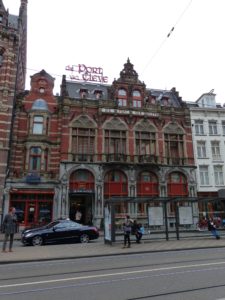

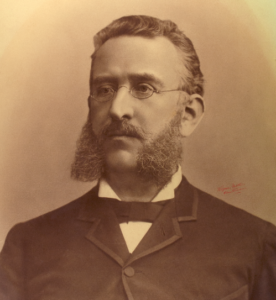
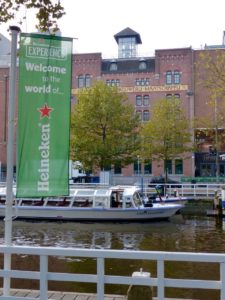
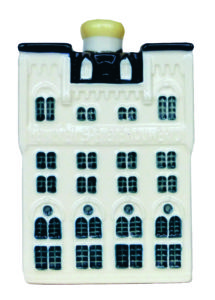
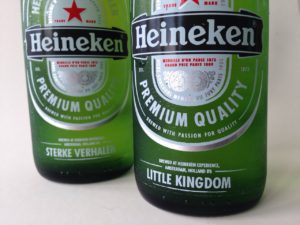
5. Urban Legend: the mysterious star of Heineken (KLM-house No. 95)
Nieuwezijds Voorburgwal 176
You see the hotel across the street, on your right, ‘De Port van Cleve’? Look at its magnificent gable. Gable stones came into use in the 16th century, and the one on the left of the entrance commemorates the roots of the beer brewing company, Heineken.
Well, let me tell you the story of the founding father. In 1864, Gerard Heineken laid the foundation for his global beer brand after purchasing a 16th-century brewery, located on this spot. Brewery ‘De Hooiberg’ (‘The Haystack’) was established in 1592, close to the city wall which surrounded Amsterdam. Since medieval times, the five-pointed red star (now part of the logo of Heineken) had been symbolizing the elements (earth, wind, water and fire). The fifth point of the star represents an unknown and magical element, which beer brewers believe has protective powers.
In 1864, when 22-year-old Gerard Heineken bought the brewery, he employed twenty people. Three years later, due to its huge success, the company was moved to a new building on Stadhouderskade 87. (KLM house No. 95 is a miniature replica of the Heineken brew house). Over 150 years, the small brewery became the largest in Europe and Heineken is the third largest beer brewing company in the world. The company remained a family-owned business as the fourth generation now controls a majority stake. Today, about 85,000 employees work for Heineken. I’ll drink to that! And now you know the true meaning of the phrase ‘Dutch courage’, although some might continue using the expression to bolster up one’s courage inspired by drunkenness.
Let us head now to our next bar, for a beer of course… Walk back the way you came and turn right into Gravenstraat.
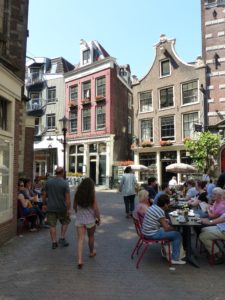
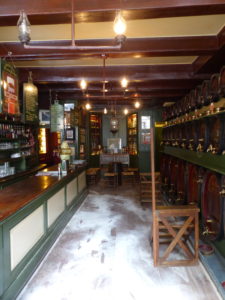
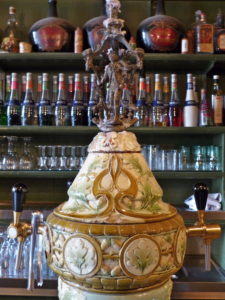
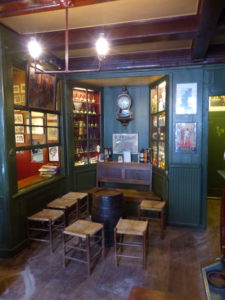
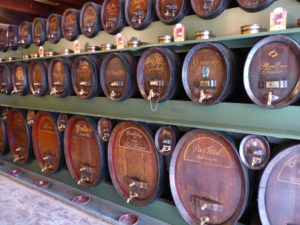
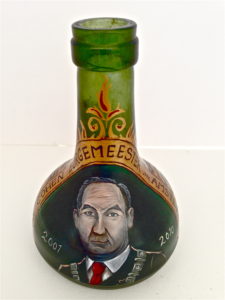
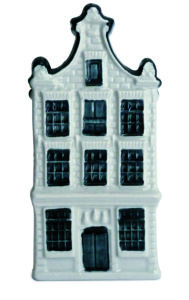
6. Tasting house ‘De Drie Fleschjes’ (KLM House No. 80)
Gravenstraat 18
Our next stop is KLM house No. 80, a replica of bar ‘De Drie Fleschjes’, meaning the three little bottles. It’s on your left, in the middle of the street. The Gravenstraat lies behind the Nieuwe Kerk (New Church) and has always been a lively little alley. In the 17th century, it was lined with inns and restaurants. In 1650, a new tavern opened its doors at number 18, adjacent to an alley with the sinister name ‘The Hole’. And there’s more to shiver about…
Just walk into ‘De Drie Fleschjes’ and in the back you’ll see a narrow bench that seats three people. It is the only place to sit here, but regulars still prefer to stand. The legend goes that eight customers died in short succession after sitting on that simple wooden bench. Their final ‘resting place’ soon earned the notorious seat the nickname ‘Dead Man’s Bench’.
This sand-strewn, barrel-lined cafe was a favorite with the mayors of Amsterdam and other notable figures from the nearby City Hall (now the Royal Palace). Since the 17th century, it has been a tradition that a departing mayor receive the honor of having his portrait painted on a bottle and, to date, some thirty mayors have been immortalized. The bottles are called kalkoentjes (little turkeys) or horseshoes. The name refers to the particular shape of the centuries-old bottle. The unique collection is on display in a cabinet, next to the Dead Man’s Bench. So, be careful…
‘De Drie Flesjes’ serves local al regional beers, traditional Dutch liqueurs and of course genever, the national liquor from which gin evolved. Tradition dictates that the first sip is taken by bending your head down to the tulip-shaped glass rather than bringing the glass to your lips. This is the best way to drink genever, as the glasses are filled to the brim!
Opposite ‘De Drie Fleschjes’, walk into Eggertstraat and continue to the Dam Square.
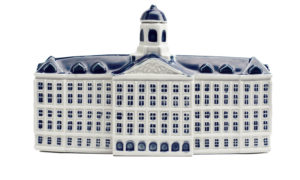

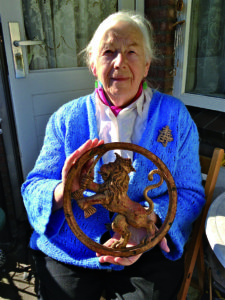
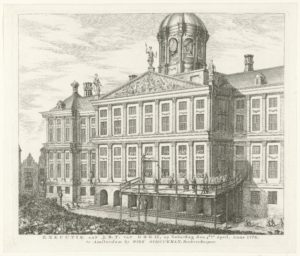
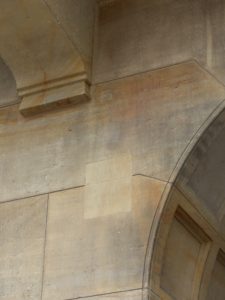
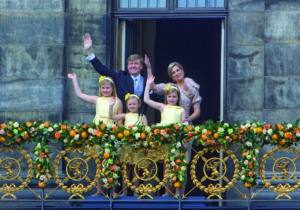
7. Urban Legend: a Scaffold turned into Royal Balcony (KLM collector’s item)
We have arrived at Dam Square. On your right is the Royal Palace, built in 1648 as the City Hall of Amsterdam. It was once called the eighth wonder of the world and a miniature universe of symmetry and perfection. The Delftware replica of the Royal Palace is a special edition of the KLM house collection, and have been given to newlywed couples embarking upon their honeymoons in Business Class. Let me tell you an urban legend about this landmark.
You see the balcony? It has been an iconic feature since 1806. In that year, Louis Napoleon, the brother of the French emperor, became king of Holland and changed the monumental City Hall into his Royal Palace. He ordered a large balcony to be built across the entire width of the facade, so he could receive his cheering crowd. On his request, metalsmith called Jan Jonker fashioned a balustrade containing 92 golden lions, with a crown, a sword and arrows, encircled by a wreath of laurel. But Jan Jonker hated the French, so he built the balcony as poorly as possible.
It is said that the French king was interested in learning the Dutch language. During one of his public appearances on this balcony, Louis decided to show what he had learned and proudly exclaimed: “Ik ben uw konijn van Holland!” The audience was dumbfounded, as their foreign ruler had just stated that he was the “rabbit of Holland”, mixing up the Dutch words koning (or king) and konijn (which means rabbit).
Nothing happened to the kings and queens and even the Russian Tsar on a state visit who all stood on the badly constructed balcony. Only in the 1930s, engineers discovered the piece was structurally unsound and had to be removed. The queen at that time, Wilhelmina, insisted on having a balcony to great her people, so a new, much smaller one was built. Mysteriously, many of the gold-plated lions from the original balustrade disappeared. Almost seventy years later, the historian Jane Borst came across the original pieces at a flea market. For 430 euros, she bought herself the royal souvenirs which now cover the walls of her house.
And just one more story before we go. Look there! You see those nine little square stones which are of a lighter color then the rest? Under the royal balcony? These small square stones cover the holes which were used to secure the scaffold, which was set up here in the 17h century. Here criminals were put to death.
Pass the palace and turn right into Damstraat. Cross the Nieuwezijds Voorburgwal and continue into Paleisstraat. Turn left into Spuistraat and continue walking
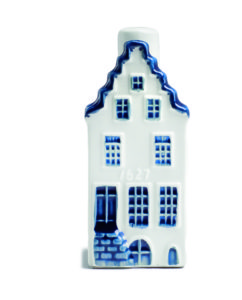
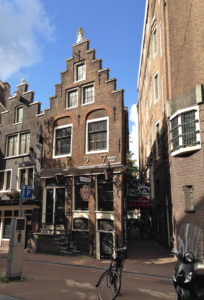
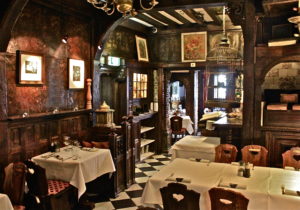
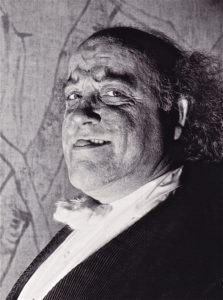
8. Restaurant ‘De Vijff Vlieghen’ (KLM-house No. 2)
Spuistraat 294
So, that was quite a walk. Further down the street, on your right, lies Restaurant ‘De Vijff Vlieghen’ (meaning the five flies). This legendary tavern is KLM house No. 2. In 1627, the building’s front in a Renaissance style was given a little flamboyant touch with a stepped gable facade. At that time, the restaurant was overlooking a canal which was later filled in and became the Spuistraat.
The name ‘Five Flies’ refers to the first owner,Jan Jansson Vlijghen, who’s last name can literally be translated as ‘flies’. So the restaurant’s name is definitively not a nickname of a disappointed customer nor does it refer the cleanliness of its kitchen. The Five Flies is a world-class restaurant, after Nicolaas Kroese became the owner in the 1930s. The Dutch celebrity and entertainer styled each of his nine dining rooms with its own Old Dutch theme and promoted his restaurant as a “culinary museum”.
In 1953, Kroese toured America as a goodwill ambassador on behalf of the Dutch Tourist Board. His colorful personality attracted large crowds, eager to witness his crazy antics. He had a large birdcage with five copper flies and a musical box made especially for the trip. Once, on Broadway, Kroese brought out the birdcage and stopped the traffic, crying, “five flies must pass!”, before entertaining passersby with tall stories about Amsterdam. The American media loved Kroese, and he attracted the attention of celebrities such as Walt Disney, John Wayne, Gary Cooper and Jayne Mansfield. The famous stars were his guests of honor when they visited Holland and dined in his restaurant.
After a colorful life, Nicolaas Kroes died in 1971 at the age of 66. To commemorate the restaurant’s 50th anniversary, a bronze plaque with his portrait was revealed on the side of the street. The culinary museum looks precisely the way it did when Nicolaas Kroese entertained his famous guests. Have a look at the gold-brass plates on the back of each chair, memorializing famous visitors including Mick Jagger, Bruce Springsteen, Goldie Hawn and Gianni Versace.
After all those years, ‘The Five Flies’ is still a top tourist attraction. When you come across Albert Veerman, the Food & Beverage Manager of the restaurant, ask him if you can make take a photo of his calf. As a tribute, he has a tattooed portrait of Nicolaas Kroese on his lower leg.
Continue along Spuistraat.
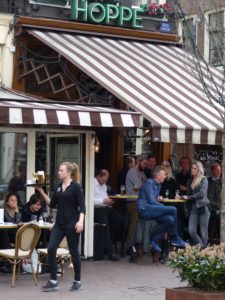
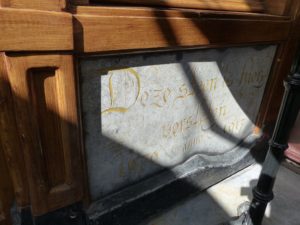
9. Café ‘Hoppe’
Spui 18-20
A few steps from restaurant the Five Flies, we stop at another famous Amsterdam institution, café Hoppe, where the city’s intellectuals have gathered for centuries to discuss politics and world affairs. The building was originally home to a distillery, founded by the Hoppe family in 1670. Cafe Hoppe is comprised of two parts, the ‘standing’ for the menfolk and the ‘sitting’ part for the ladies. The part on the right is declared a national monument, and the interior reflecting its rich history. Notice the worn threshold stone, which was moved to the right of the front entrance. It refers to the founding date of the establishment, 1670.
Just walk inside. You see that they also have sand on the floor. This is refreshed every day. And listen: no music is being played, which is rather special for a café. The atmosphere in Café Hoppe is laid-back and the fare is pretty simple. Hoppe is known for its typical Dutch combination of beer and bitterballen. Every day after 5 pm, the café fills up with expensive suits on their way home from the office. Even the late Mr. Heineken was a regular, but he never ordered his own beer.
After a drink at café Hoppe, let us cross the street and continue our historic pub crawl. Just walk past bookshop Athenaeum (or just go in and buy a copy of Mark’s book ‘Kingdom by the Sea’). Cross the Nieuwezijds Voorburgwal and continue past the American Book Center.
On your left is a small doorway to the Begijnhof, one of Amsterdam’s top 10 attractions and open to the public until 5 pm daily. Go through there and I will tell you another urban legend. Mind your step when entering the courtyard.
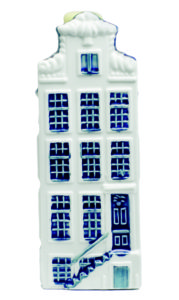
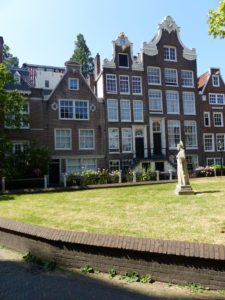
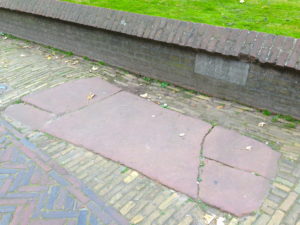
10. Urban Legend: a ghost in the gutter (KLM-house No. 46)
Begijnhof 27
Since 1346, this was the domain of the beguines. These women were committed to helping the sick and the poor. As such, they spurned marriage, took vows of chastity, and often gave away all their possessions. In the 16th century, houses of stone were built here. The bricks for these were made by mixing the local clayish sand with brackish water from the canals, which at the time were still directly connected to the Zuiderzee. The salt from the water crystallized in the bricks and the rumor goes that, if you lick Amsterdam’s 17th-century walls today, you can still taste the salt from the Dutch Golden Age. Only the thought makes you want to have another drink right?
KLM miniature No. 46 is a replica of Begijnhof 27. The house was built in around 1740. It has a lavishly decorated, Louis XIV clock gable topped by a golden crown. You see that Madonna figure holding a child against her naked breast? At some point in the past, the bare breast had been painted over. The Madonna was returned to her rightful, but more revealing, state of dress as part of the restoration in 2009.
What about the ghost story? Well, a woman called Cornelia Arents lived in the Begijnhof and upon her death on May 2, 1654, the Catholic lady asked to be buried under the patio of the courtyard. She considered the English church in the courtyard to be profaned by the Presbyterians. Her request was denied and Cornelia was laid to rest in the church. The next morning her coffin was found lying in the gutter. After this mysterious incident repeated itself three times, Cornelia’s wishes were honored and and she was buried here in the gutter. A commemorative stone can still be seen at the site of her grave.
Suffix navigational story
The houses around the courtyard are still occupied by 105 single women. Tourists are asked to respect their privacy. Walk around the English Reformed Church and that the exit. Continue walking through the alley into Begijnsteeg.
Cross Kalverstraat and walk along Watersteeg. Turn right at the end and cross the street to your left into Rokin. Walk east into Langebrugsteeg. Turn left here into Oudezijds Voorburgwal and continue walking.
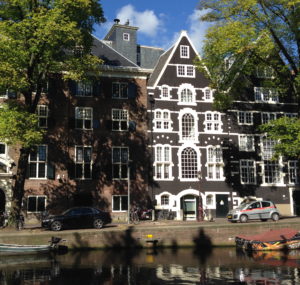
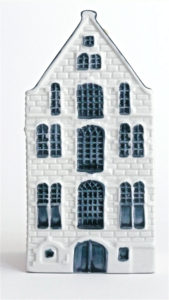
11. The City Bank of Amsterdam (KLM-house No. 37)
Oudezijds Voorburgwal 300
Here on your left, on number 300, is the City Bank of Amsterdam. This is not just a bank, it is the municipal pawnbroker, So if you ran out of money buying drinks, you can have your watch pawned here. But don’t pawn your smartphone! You still need it for the rest of the tour.
Continue walking along the canal, cross Damstraat and continue walking. Turn left into Pijlsteeg.


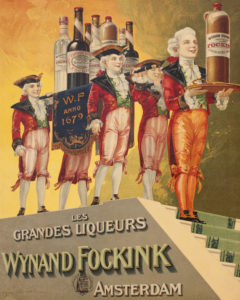
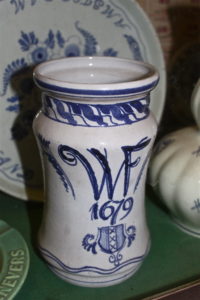
12. Tasting house Wynand Fockink (KLM-house No. 11)
Pijlsteeg 31
We walked along the jam-packed Oudezijds Voorburgwal, one of the brightest buzzing and busiest of the Red Light District’s neon streets. Now we are in the Pijlsteeg and on your right hand side is our next stop, it’s KLM House No. 11. Wijnand Fockink is a tasting house dedicated to Holland’s traditional signature liquor, genever. It was founded in 1679, and is now part of the Bols distillery.
In the 15th century, Amsterdam’s world famous Red Light District was born in this tiny alley, where a blind eye was turned to prostitution. The tasting house’s location turned out to be a great choice; nervous brothel clients would build up some Dutch courage first before they patronized the nearest brothel… After all, it was just a small step from exotic fruit, the basis for liqueurs of the imported variety, to forbidden fruit.
Genever is still distilled and sold on-site, and don’t be surprised if you find yourself leaving with a bottle or two as a souvenir. In this alley, about one hundred different genevers are produced according to the traditional distilling methods. One of the home made liquors is called ‘Little Hans in the Cellar’, and it is based on a 17th-century recipe. During the Golden Age, pregnant women served the liqueur in a special silver chalice. When the drink was poured, a lid at the top flipped open and a small child popped out. Little Hans! In this way, the mother-to-be subtly told those around her that she was pregnant.
Walk back the way you came and turn left at the end of the alley. Walk north along Oudezijds Voorburgwal.
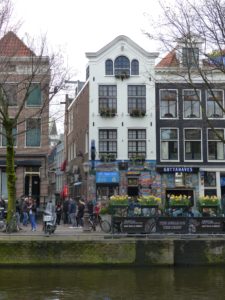
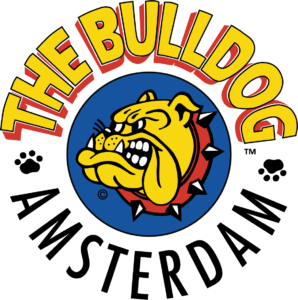
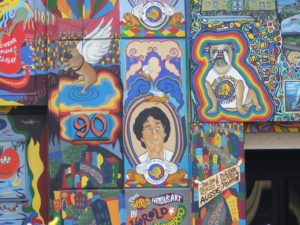
13. Coffeeshop Bulldog The First
Oudezijds Voorburgwal 90
On your left, at number 90, is the location of the first coffeeshop in Amsterdam. It started in a former sex-shop located in the cellar of this house. It used to be a meeting point for friends of the owner Henk de Vries, to smoke a joint in secret. In the seventies, tourists discovered how to find the place and The Bulldog was born. The coffeeshop was named after Joris, the owner’s dog.
It’s not a surprise the façade of the bar is decorated by a cannabis smoking artist. The founding father of an emporium of now five coffee shops and two hotels is immortalized next to the entrance. Henk de Vries is hailed as the ‘greatest genius that ever lived’.
In the early days, when soft drugs were illegal, the Bulldog was often raided by the police, but the staff knew many smart hiding places for cannabis. The bar has earned its place in history and it’s much more than just a cellar. There’s a comfortable shop upstairs and downstairs, a souvenir shop and a canal-side patio if you like to smoke weed outside. It’s not illegal anymore, as long as the cannabis is for personal use. The police only complain that they are not allowed to have a joint themselves when they are off-duty. They must set the public a ‘good moral example’.
Continue your walk along the Oudezijds Voorburgwal.
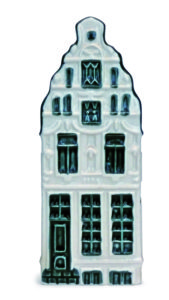
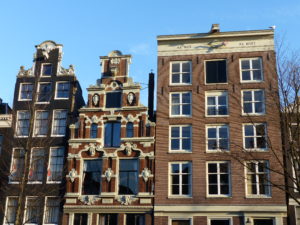
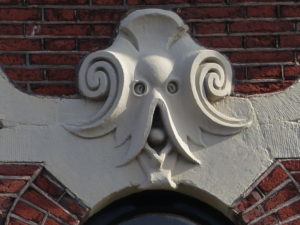

14. Urban Legend: the myth of Darth Vader (KLM-house No. 10)
Oudezijds Voorburgwal 57
We are on our way to one of the last bars on our historic pub crawl. And just when you thought you’ve seen it all, you come across a 17th century image of Darth Vader! Yes, the fictional character from the Stars Wars movies left his mark on Amsterdam, centuries ago. When you pass the Old Church, you’ll notice a historic building at the other side of the canal. This is KLM house nr. 10. It was designed by the famous architect Hendrick de Keyser in 1615. The upper facade of this house, which has number 57, is richly decorated with sculpted male and female heads, and a number of fantasy monsters.
Several ornaments show the head of a praying mantis. But when you look closer, you see that it’s an image of Darth Vader. In most cultures, the praying mantis is a symbol of contemplation. Mantis is the Greek word for “prophet” or “seer”; a being with spiritual or mystical powers. Word has it that seeing a praying mantis is a sign of good fortune. In the Arabic and Turkish cultures, a mantis points pilgrims towards Mecca, the holiest site in the Islamic world. In Africa, they help to find lost sheep and goats and, in France, it is believed that, if you are lost, the mantis points the way home. Well, let the praying mantis on this house guide you through to the end of our historic pub crawl… and back to the future!
Continue your walk along Oudezijds Voorburgwal.
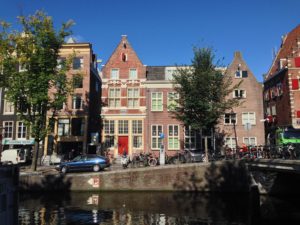
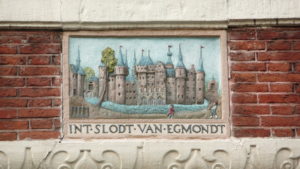
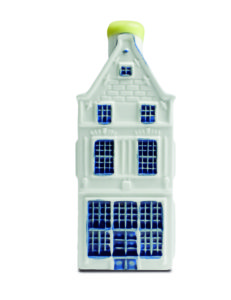
15. Urban Legend: a sign of the times (KLM-house No. 8)
Oudezijds Voorburgwal 18a
As we continue along Oudezijds Voorburgwal, we pass on our left, number 30, ‘Brouwerij de Prael’, or a brewery. We are not entering the venue, but we’ll pass their tasting room in a few minutes. I want to tell you about another KLM house, no. 8. It is on number 18a. Is there anything special you notice? This house looks like an exact replica of the house with the images of Darth Vader. The two are almost identical. The houses were built around 1615, in a typical Amsterdam Renaissance style, the trademark of the architect Hendrick de Keyser.
Both houses share a number of features in common. You see? The gables are decorated with lion masks, the facades have identical, ornate string courses and the double pilasters are each graced with an elegant pointed arch, punctuated in the center by sculpted portraits. But the big question remains: are both these houses the “real” works of master De Keyser, or did someone shamelessly copy him? Time for a last drink, to discuss the matter in detail… Before we take the alley to the left, can you see how the house on this corner is leaning forward. Don’t worry, you are not drunk; it was built that way. Like many 17th century monuments, this house leans forward in order to help keep rain off the façade. And this kind of historic building style was even copied just around the corner.
Walk left into the Oudezijds Armsteeg.
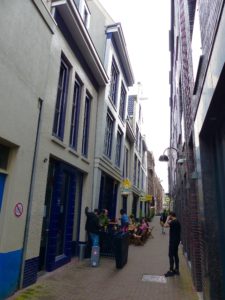
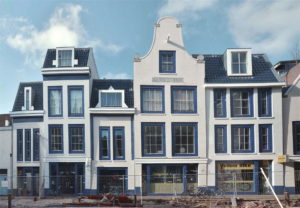
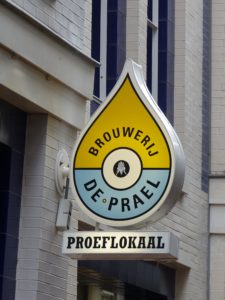
16. Tasting room ‘De Prael’
Oudezijds Armsteeg 26
This is a very special alley. In 2010, six houses built here were inspired by the iconic KLM house collection. Like the miniatures, the Delft blue and white houses have glazed, dark blue roofs and white facades. And some of them lean forward, just like the 17th century monuments we’ve just passed. This real estate project is called ‘Out of the Blue’, and is home to the bar of the beer brewery De Prael. They name their beers after famous singers from Amsterdam. We have one more bar to visit before our Historic Pub Odyssey comes to an end. So grab a beer inside or continue walking.
Continue along the alley and turn right at the end. Continue along Warmoesstraat. Cross Nieuwebrugsteeg and go into the alley: Sint Olofspoort.
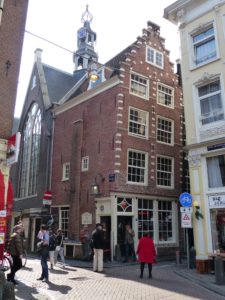
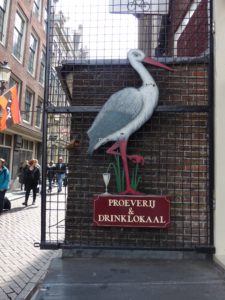

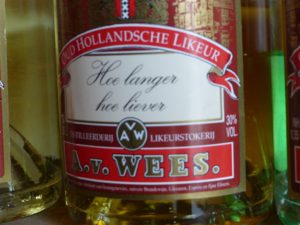
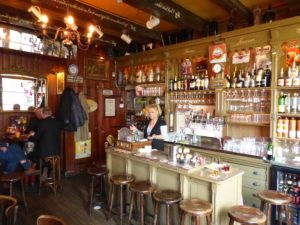
17. Tasting room ‘De Ooievaar’
St Olofspoort 1
At the end of the alley is our final destination.
It is ‘De Ooievaar’ on the right hand corner and it is is just across the street from the starting point of our Amsterdam Historic Pub Crawl. ‘De Ooievaar’ (‘The Stork’) is a one-room bar. It is associated with the A. van Wees distillery, which claims to be the last authentic distillery in Amsterdam. The bar is named after a stork, because this kind of bird often builds its nest on top of a distillery chimney.
‘De Ooievaar’ is much older than the distillery, and was established in 1605. After the Protestants took over Amsterdam from the Catholic town council in 1578, they banned drunken boozers for a while – so the citizens labeled their hooch ‘medicine’ and drank it anyway. ‘The Stork’ became one of those local ‘pharmacies’.
This is our last stop and if you found this historic pub crawl a bit exhausting, just order a hardboiled egg from the bar as an energy booster. It’s a local tradition! I hope you’ve enjoyed this walk through historic Amsterdam. Anyway, it was a good excuse to share some drinks. Maybe we meet again, during one of the other walks based on the KLM houses and the book ‘Kingdom by the Sea’.
If you like to hear more stories about Holland, and fascinating urban legends, then visit the shoppingpage of this website. Thank you for being our guest on this journey through time, and I hope to see you on one of my other tours as well.

Mark Zegeling
Author Kingdom by the Sea,
A celebration of Dutch cultural heritage and architecture
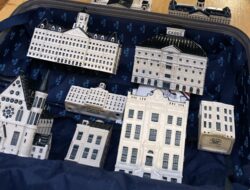
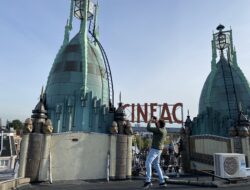
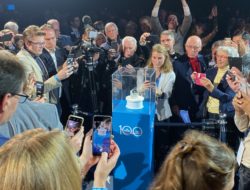

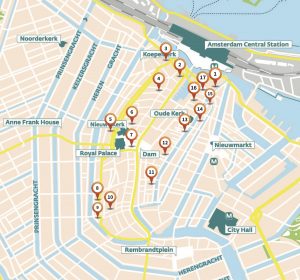
 Frits Bolkenstein
Frits Bolkenstein